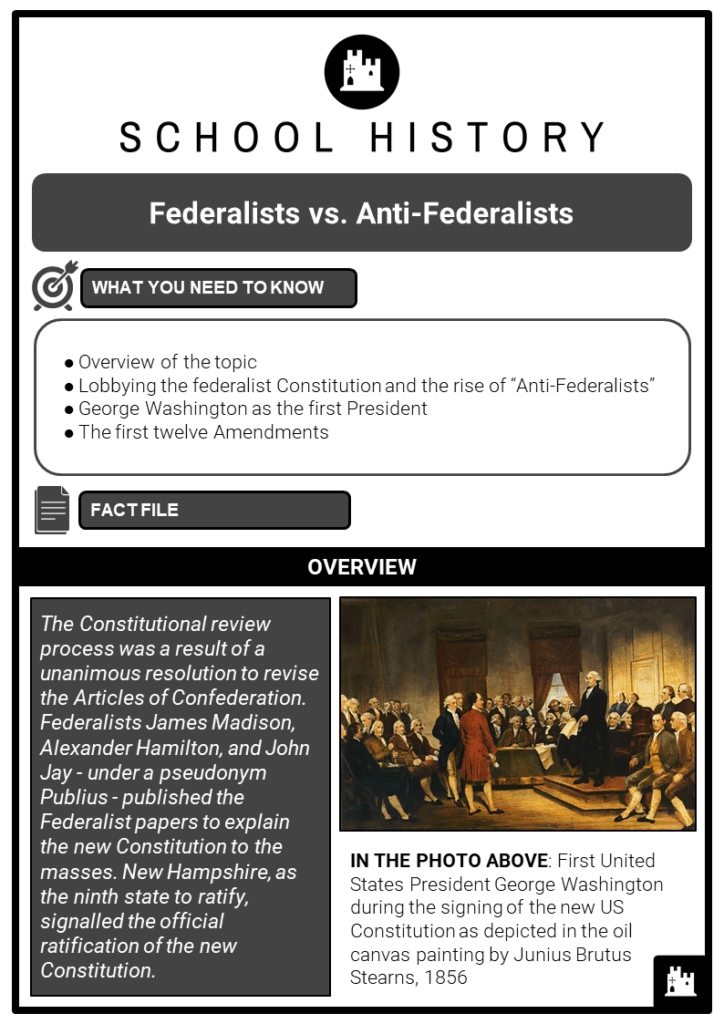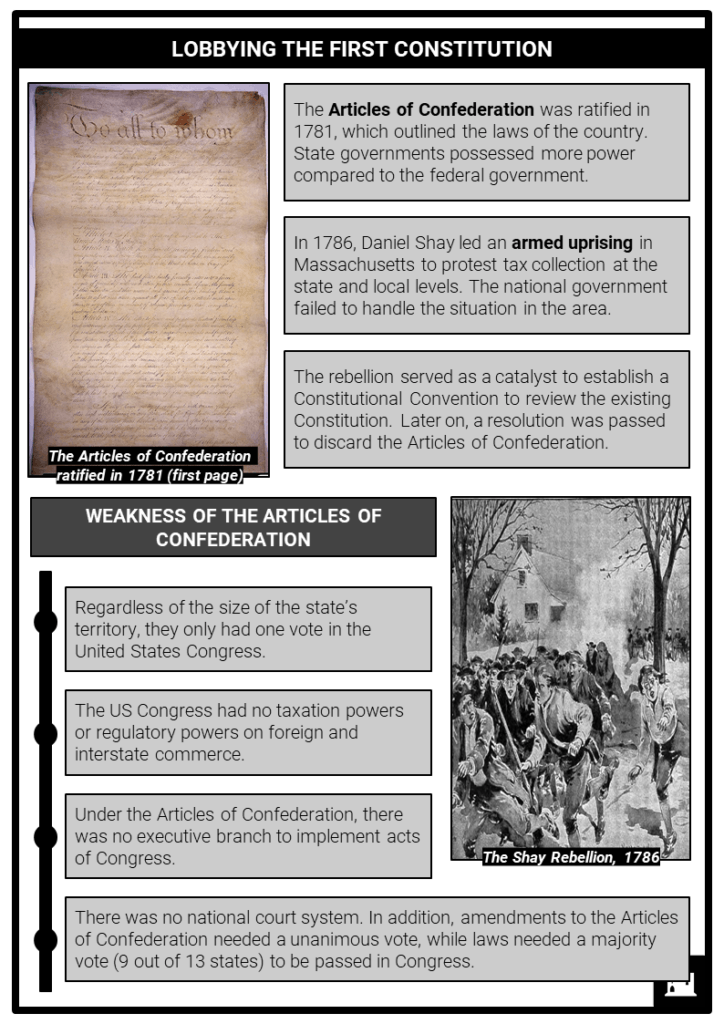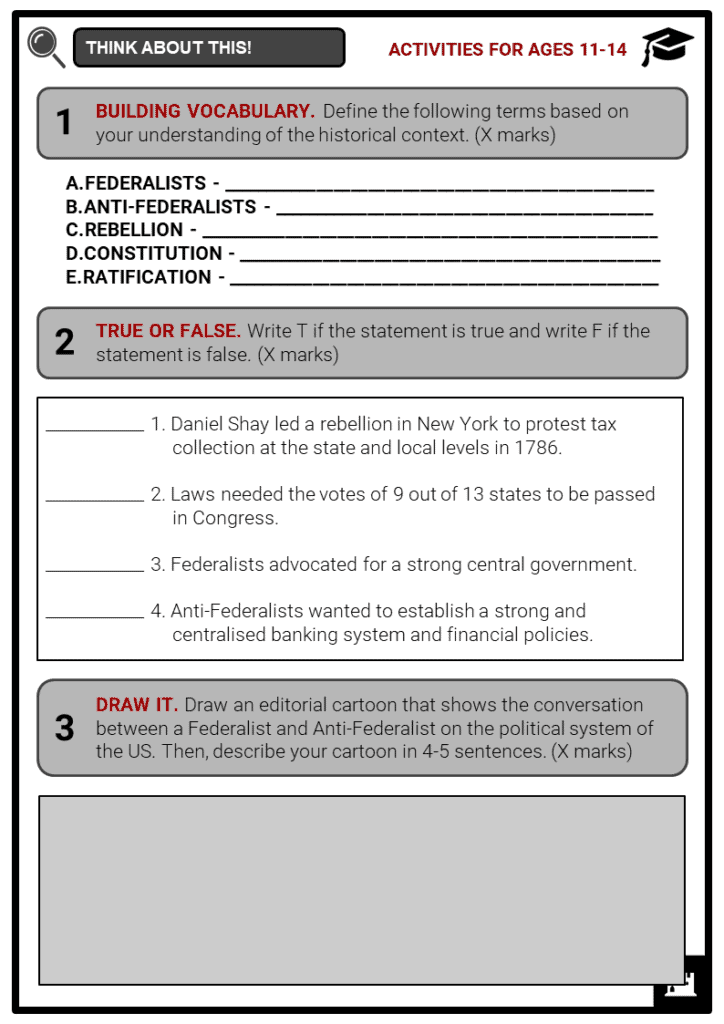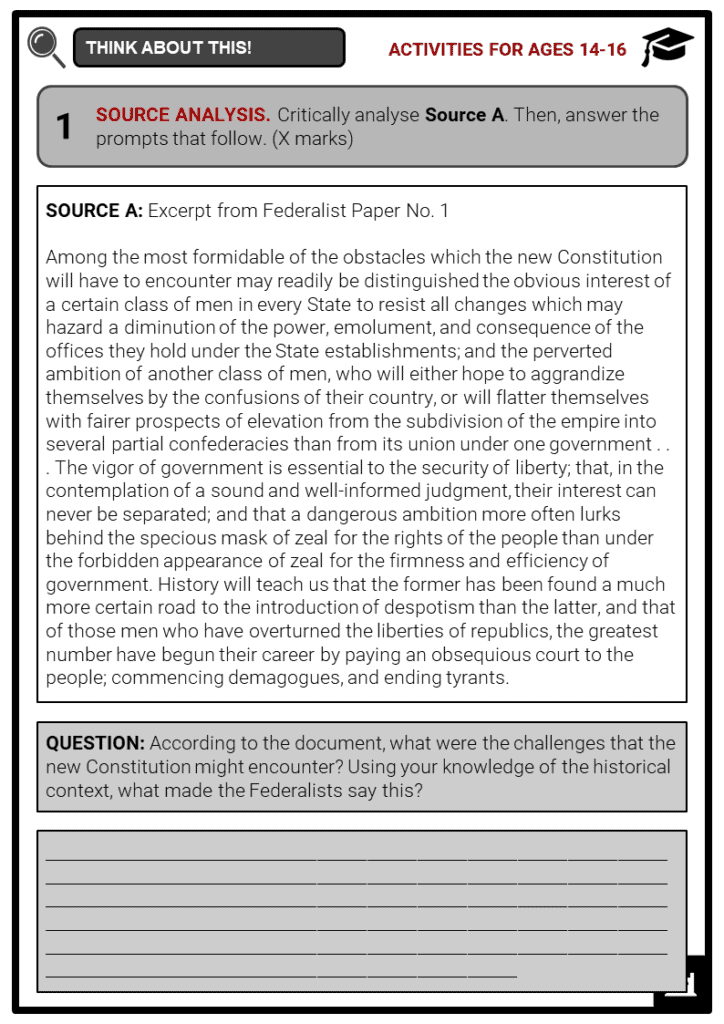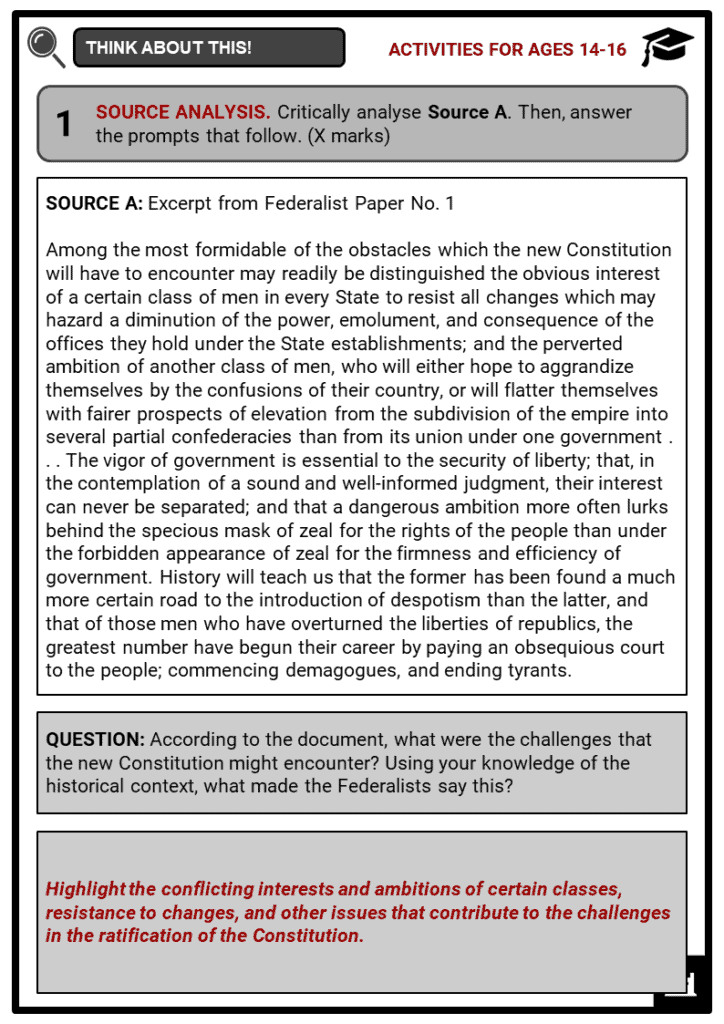Download Federalists vs. Anti-Federalists Worksheets
Do you want to save dozens of hours in time? Get your evenings and weekends back? Be able to teach Federalists vs. Anti-Federalists to your students?
Our worksheet bundle includes a fact file and printable worksheets and student activities. Perfect for both the classroom and homeschooling!
Table of Contents
Add a header to begin generating the table of contents
Summary
- Overview of the topic
- Lobbying the federalist Constitution and the rise of “Anti-Federalists”
- George Washington as the first President
- The first twelve Amendments
Key Facts And Information
Overview
- The Constitutional review process was a result of a unanimous resolution to revise the Articles of Confederation. Federalists James Madison, Alexander Hamilton, and John Jay - under a pseudonym Publius - published the Federalist papers to explain the new Constitution to the masses. New Hampshire, as the ninth state to ratify, signalled the official ratification of the new Constitution.
Lobbying The First Constitution
- The Articles of Confederation was ratified in 1781, which outlined the laws of the country. State governments possessed more power compared to the federal government.
- In 1786, Daniel Shay led an armed uprising in Massachusetts to protest tax collection at the state and local levels. The national government failed to handle the situation in the area.
- The rebellion served as a catalyst to establish a Constitutional Convention to review the existing Constitution. Later on, a resolution was passed to discard the Articles of Confederation.
Weakness Of The Articles Of Confederation
- Regardless of the size of the state’s territory, they only had one vote in the United States Congress.
- The US Congress had no taxation powers or regulatory powers on foreign and interstate commerce.
- Under the Articles of Confederation, there was no executive branch to implement acts of Congress.
- There was no national court system. In addition, amendments to the Articles of Confederation needed a unanimous vote, while laws needed a majority vote (9 out of 13 states) to be passed in Congress.
- CONCERNS FROM THE DELEGATES: When the Constitution was completed, concerns arose as to whether states would approve it or not. The Articles of Confederation required unanimous approval from the states. It was not feasible given the strong opposition from some states such as Rhode Island, New York, Massachusetts, and Virginia. These states were against the idea of having a strong central government.
- COURSE OF ACTION: In light of this situation, the delegates of the convention decided that they would pursue the approval of at least 9 out of 13 states to ratify the new Constitution. The convention leaders submitted the documents to the states and decided that there would be conventions within the state where people would discuss the Constitution then pass a vote to approve or reject it, as opposed to going through state legislatures.
- RECEPTION BY THE PUBLIC: The public was shocked by the changes between the Articles of Confederation and the new Constitution, with the perception being that the convention would only amend the former and not completely alter the political system.
Federalists
- Supporters of the Constitution were called “Federalists” since federalism was understood as being the opposite of centralised power.
- Benjamin Franklin and George Washington were proponents of federalism. James Madison, Alexander Hamilton, and John Jay - under a pseudonym Publius - took to the newspapers to explain the Constitution as their advocacy strategy
- for its adoption within the states.
- Hamilton and Madison argued that the Bill of Rights was not needed since it may place limits on the rights of the people.
- A strong national government was necessary to manage debt and tensions brought about by the American Revolution.
- In terms of fiscal and monetary policies, Federalists wanted centralised banking and financial policies.
- Jointly, they wrote eighty-five (85) essays which are presently known as The Federalist Papers. It revolved around five themes: checks and balances, separation of powers, pluralism, and representation.
- Through these series of papers, the authors were able to address the fears that some people had concerning the new Constitution, including the control of the militia.
Anti-Federalists
- Cynicism was at the root of opposition of anti-Federalists to the Constitution, according to the Federalists.
- The most prominent Anti-Federalists were Samuel Adams and Patrick Henry, whose main concern was that the Constitution would favour elites over common folk, weaken state governments and result in an increase in taxes.
- Most Anti-Federalists were farmers, debtors and lower-class people with their most pressing objective being the absence of a Bill of Rights to counter the powerful central government.
- Anti-Federalists were not convinced that republicanism was possible in countries like America since the only examples at the time were Switzerland and the Netherlands.
- Anti-Federalists preferred that power should remain in the local and state governments, since they were “free agents.”
- In terms of fiscal and monetary policies, Anti- Federalists felt that states should decide and manage their revenue.
- Until a Bill of Rights was excluded in the proposed Constitution, the Anti- Federalists would not support its ratification.
- THE ANTI-FEDERALIST PAPERS: To counter the claims of Federalists in their Federalist Papers, the Anti-Federalist founding fathers published a series of essays, known as the Anti-Federalist Papers, that expressed concern or strongly opposed the ratification of the United States Constitution of 1787.
The Ratification Of The Constitution
- In December 1787, Delaware, Pennsylvania and New Jersey were the first states to ratify the Constitution.
- However, the framers understood the importance of the Constitution being accepted by all thirteen states. They continued in their advocacy and finally, in the summer of 1788, Virginia and New York ratified.
- New Hampshire was the ninth state to ratify, meaning the threshold of nine out of the 13 colonies was achieved. The Constitution came into effect, and the Continental Congress gave way to the new Congress with New York as its headquarters. March 4, 1789, was the date set for the first Congress to convene.
- Between January and May of 1788, Georgia, Connecticut, Massachusetts, Maryland, and South Carolina accepted it.
- North Carolina and Rhode Island waited until the new Congress fulfilled its promise to draft a Bill of Rights. North Carolina ratified on 21 November 1789, and Rhode Island on 29 May 1790.
George Washington As The First President
- George Washington was the first President of the United States, and the only President in US history to win the presidency by a unanimous vote in the electoral college. Throughout his Presidency, Washington was anxious about leading the young nation through the uncertainties that lay ahead.
- He was successful because of his negotiation abilities and commitment to address the deep divisions that had arisen through the Revolutionary War and the Constitutional debate. He surrounded himself with wise people such as Vice President Adams and Attorney General Edmund Randolph.
- Thomas Jefferson was head of the Department of State and Alexander Hamilton, head of Treasury. Congress established the Judiciary, a six-member Supreme Court, three circuit courts and 13 district courts. Washington appointed John Jay as Chief Justice, Head of the Judiciary.
The First Twelve Amendments
- Among the hesitation behind the states failing to ratify the Constitution was that the central government’s unfettered powers would take away civil liberties. The Federalists had made a commitment that the Bill of Rights would be the first priority of the new Congress.
- James Madison led the amendment of the Constitution to include the Bill of Rights. He drafted 17 amendments, but only 12 were approved by a two-thirds majority in both houses - Senate and House of Representatives - as well as 3/4 of the states as provided in the Constitution.
- Ten of those amendments formed the Bill of Rights, the other one gave additional powers to the states, and the third one was a right guaranteeing adherence to the Bill of Rights even on issues not expressly provided for in the ten amendments.
Two Rejected Amendments, The Bill Of Rights
- THE CONGRESSIONAL PAY AMENDMENT: This was proposed to limit Congress from increasing their salary. It was, however, approved in 1992 as the 27th Amendment of the Constitution.
- ARTICLE THE FIRST: It provided a formula for the number of House members based on each decennial census. If approved, the House of Representatives would be between 800-5000 members, against 435.
- The approved Bill of Rights included freedom of the press, religion, speech, and assembly; the right to firearms; the right to refuse to quarter soldiers on private property; the right to trial by jury, protection against unreasonable searches and seizures; and protection against cruel and unusual punishment. The tenth amendment gives the states Residual Powers by providing that the States have powers not delegated to the federal government and not prohibited to be exercised by the states governments.

